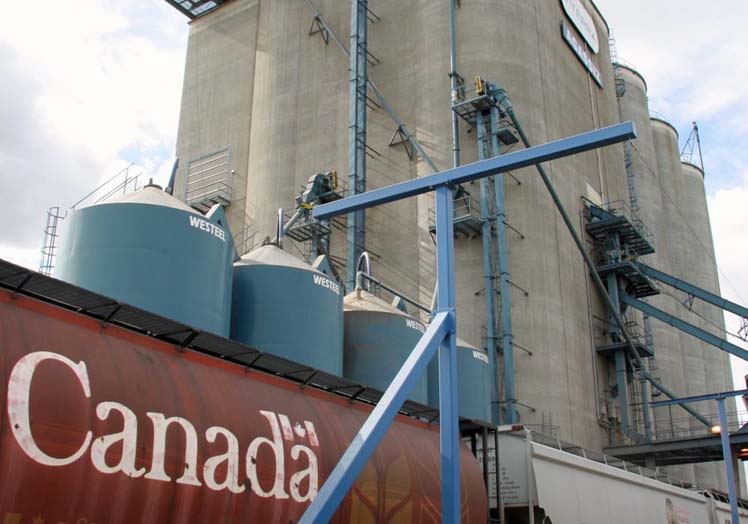
Canada - Western Canadian grain shipments are moving well this crop year, but exports could be even higher.
The limitation, according to Mark Hemmes, Canada's grain monitor and president of Quorum Corporation, is the ability to move the crop between country elevator
and port terminal by rail.
"Grain companies generally do not market grain based on global market demand, but on what rail capacity they think they can obtain," read a slide
Hemmes presented during a talk at Crop Connect in Winnipeg 13 Feb 2019.
So if the railways provided enough capacity to meet grain companies' full demand would it increase competition among companies for farmers' grain?
Yes, says Wade Sobkowich, executive director of the Western Grain Elevator Association (WGEA).
"If grain companies can move more during the peak period (when international prices are their highest) they will be competing more aggressively to attract
that grain from the farmer during that same period," he said in an interview 15 Feb 2019.
Sobkowich has often said WGEA members, some of Western Canada's biggest grain companies, sell based on what they think the railways can deliver.
When they book export sales beyond that it results in demurrage and cancelled contracts, costing grain companies millions of dollars and tarnishing their
reputations as reliable suppliers.
During peak demand grain companies could fill twice as many cars as the 5,500 and 4,000 a week Canadian National (CN) and Canadian Pacific (CP) are each
offering, during non-winter and winter months, respectively, Sobkowich said in an interview last year.
"We don't expect the railways to gear up to provide 18,750 rail cars a week right off the bat, but it should be a number that they're striving for,"
he said 22 Aug 2018.
The WGEA has long maintained the railways don't move all the grain the companies want to ship at certain times because as functional monopolies they don't have
to.
Grain companies have few economic alternatives to rail.
The railways don't invest in costly surge capacity knowing they'll move most of that grain eventually when capacity is available, according to the
WGEA.
The railways counter that they are continually investing in additional capacity, but demand from grain and other products fluctuates.
They must balance shipper needs with costs.
Hemmes agrees lacking rail competition affects grain shipping.
"It's in the interest of the railway to have the same amount of traffic moving every week, 52 weeks a year," he said in an interview after his
presentation.
"But that's not the way commodities get sold."
The WGEA is generally pleased with rail service this crop year, Sobkowich said.
CN and CP supplied a combined 87 percent of hopper cars ordered in grain week 27, the Ag Transport Coalition's weekly report issued 8 Feb 2019
said.
The railways are close to meeting the targets they set for themselves, not what the companies would ship if the railways could meet the demand, Sobkowich
said.
Record grain volumes were shipped to port up until December, Hemmes said.
There were issues getting cars into and unloaded at Vancouver in December, severe enough to prompt the Canadian Transportation Agency to
investigate.
That was followed by two derailments on CP and bitterly cold weather, which results in shorter trains, he said.
"So all things considered I think so far this year we've been doing really well with those isolated exceptions," he said.
But not only are the railways not fully meeting grain shippers' seasonal demand, they're slipping when it comes to meeting annual demand, Hemmes
said.
Over the last six years Canadian grain production has been growing by 2 1/2 to 3 percent a year, he said.
"We've had this the last four years where we're seeing this gradual increase in the carry-out of Canadian grain and what that says is that every year
we're failing to move a certain portion of our crop," Hemmes said.
"Somewhere between two million and three million tonnes last year could've moved. It could have been sold. We didn't because the capacity to move it to a
port position wasn't there. I think in the long term we've got some things to keep a watch on and be mindful of all the things that can go wrong, things that
could almost be read as systemic issues. And it's not a problem in the country and it's not a problem at the port. So what's left? It's got to be right in the
middle (the railways)."
West Coast car cycles had typically been 13 to 14 days in recent years, Hemmes said.
"We're seeing car cycles that are 16 days, and some months they're going up to 18 days," he said.
"That's not going to get you the capacity that you need."
The longer car cycles are likely a combination of too few rail crews and locomotives and increasing total traffic, he said.
"You're seeing increases in container movements, in coal movements, and potash wants to move more," Hemmes said.
"So with those increasing demands puts a greater stress on the railways and they're just having to catch up."
The impact from oil is minor, accounting for just 2 to 5 percent of total traffic, compared to grain at 17 (CN) and 22 (CP) percent, he said.
The railways say they are gearing up to meet the growing demand to ship more grain by hiring more staff, buying more locomotives, adding more track, buying
new, high-capacity cars, and running longer trains.
Allan Dawson.
provisions in Section 29 of the Canadian
Copyright Modernization Act.

